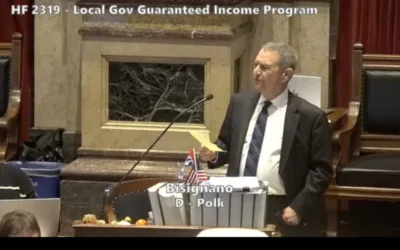
MIND AND I // Shutterstock
8 things to do right now in your community to prepare for climate change
Climate anxiety and climate-related trauma are mental health concerns rooted in real experiences, such as natural disasters, and existential worry for the future.
Roughly half of young people—those who will inherit the consequences of climate change complacency and live through the most severe effects of extreme weather—report that climate change negatively affects their daily lives, according to a global survey of 10,000 people between the ages of 16 and 25. The majority of respondents said that in the context of climate change, they are frightened of the years ahead.
This concern is prevalent in the United States as well, with more than half of Americans stating climate change is the single most important issue facing society today. Large swaths of the U.S. are facing climate-related flood risks due to rising sea and freshwater levels and increased rainfall. Roughly 80% of the country is experiencing unusually dry conditions, most notably the Western U.S., which has been gripped by a megadrought. Cities are getting hotter, while wildfires are growing in frequency and intensity. At present, virtually every bit of the U.S. is impacted by climate change.
And yet, most people have done little, or nothing at all, to change their behavior to mitigate their own impact on the environment. When facing a problem so extensive, it can be overwhelming even to attempt to find a manageable solution. But starting small—and starting at all, really—is one of the most important things you can do.
Westfield compiled a list of eight ways people can prepare their communities for the impacts of climate change. Building climate resilience, or the ability to prepare for and respond to climate-related events, may also help ease climate anxiety, improving both the environment and one’s quality of life.
Richard Pratt // Shutterstock
Plant a rain garden or install a rain barrel
Rain gardens can help prevent erosion, absorb standing water, redirect and filter polluted runoff, and recharge groundwater supplies. A single rain garden can treat 25,000 gallons of water each year. In regions of the county like the Northeast, where climate change is predicted to lead to more heavy downpours and flooding, rain gardens can mitigate those issues. In severely drought-prone areas, a rain garden won’t be effective, but a rain barrel can help collect water.
Ray Geiger // Shutterstock
Remove invasive plant species from parks
Invasive species often thrive under the extreme conditions of climate change. Plants grow larger and faster when higher carbon dioxide levels—a key consequence of climate change—are present. Research suggests invasive species are more effective at utilizing higher CO2 concentrations. As they grow larger and more prolific, they outcompete native species for space, water, light, and nutrient resources. Removing invasive species cancels this competition and allows native species to thrive.
PT Hamilton // Shutterstock
Replace grass lawns with eco-alternatives
According to the Environmental Protection Agency, Americans use a combined 8 billion gallons of water every day for lawn and garden irrigation, some of which is lost to evaporation and runoff. The majority of household water usage is diverted to outdoor purposes. This is a hugely wasteful use of scarce water resources in severely drought-ridden areas like the American West, and as a result, nonfunctional turf grass is banned in many places. Climate-friendly alternatives include no-mow lawns, turf lawns allowed to grow wild, lawns comprised of drought-tolerant native plants that thrive under local conditions, usually requiring less water, or xeriscaping.
AlyoshinE // Shutterstock
Use renewable energy options
Some households have the option to choose the source and supplier of their electricity. Where wind or solar is available and compatible, customers may opt for these cleaner sources compared to fossil-fuel-generated electricity. Alternatively, getting set up with solar panels and other renewable energy sources will provide greater energy independence in the face of power outages from natural disasters.
Gaston Cerliani // Shutterstock
Use natural methods to repel mosquitoes
Climate change has already prolonged mosquito season by more than a month, with more mosquito days expected in the future. Mosquitoes thrive in temperatures between 50-95 degrees Fahrenheit and relative humidity of 42% or higher. An analysis of 239 sites across the U.S. revealed these conditions are becoming more common due to climate change. These changes bring an increased risk for the spread of mosquito-borne illnesses like West Nile virus. Some natural ways to repel mosquitoes as mosquito days increase include essential oils, witch hazel, and citronella.
A3pfamily // Shutterstock
Plant trees
Trees are stalwart defenders against climate change, particularly in urban heat islands, which often lose trees to housing and infrastructure development. Trees can mitigate the impacts of extreme heat by releasing water vapor and cooling the air around them, as well as shading the ground beneath them. Their absorbent roots reduce flooding and prevent soil erosion. Residents can seek out community planting or beautification organizations that plant and maintain trees in public spaces.
AYA images // Shutterstock
Support local farmers
Farmers are facing less reliable growing seasons due to climate change. Some have been forced to fallow fields because there isn’t enough water to sustain their crops. In other parts of the country, too much rain is drowning young plants. Invasive species which thrive under extreme conditions are decimating the crops that do succeed. Supporting local farmers contending with these variables will not only keep the cost to consumers down but will also ensure growers stay in business. Community-supported agriculture groups exist across the country, and many communities and local co-ops sponsor regular farmers markets, where local farmers have direct access to the buying public.
Atstock Productions // Shutterstock
Get elected to HOA or neighborhood association
Getting involved at a hyper-local level through a homeowner or neighborhood association can position you to effect small but impactful immediate changes, initiate climate-centric conversations, and find a group of people working towards the same goal. HOAs often provide access to volunteering opportunities, as well as standardized maintenance protocols, which can mitigate the overuse of water and other resources.
This story originally appeared on Westfield and was produced and distributed in partnership with Stacker Studio.

Big corporations are suing to block Biden’s efforts to lower costs
From the cost of medication to education to everyday expenses, the Biden administration has passed several laws and implemented many federal rules...

Iowa Republicans make outlawing gay marriage key 2024 campaign priority
Iowa Republicans have made outlawing gay marriage a key goal in their 2024 party platform. During the Iowa GOP’s 2024 state convention on Saturday,...

Department of Justice says Iowa immigration law violates US Constitution
If Iowa doesn’t suspend the enforcement of its new immigration law by May 7, the state could face a federal lawsuit, according to the Des Moines...

Rushing: Iowa State president said the quiet part out loud
I want to thank Iowa State University President Wendy Wintersteen for doing us all a favor by finally saying the quiet part out loud: all the...

Iowa sets aside almost $180 million for year two of voucher program
Iowa has committed nearly $180 million in taxpayer funds to support private school tuition in the 2024-25 school year, which is almost $50 million...

Kalbach: Immediate action needed on corporate ag pollution
Iowa agriculture has undergone substantial changes over the past 40 years. We see it all around us. Rather than crops and livestock being raised on...












